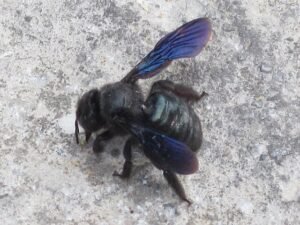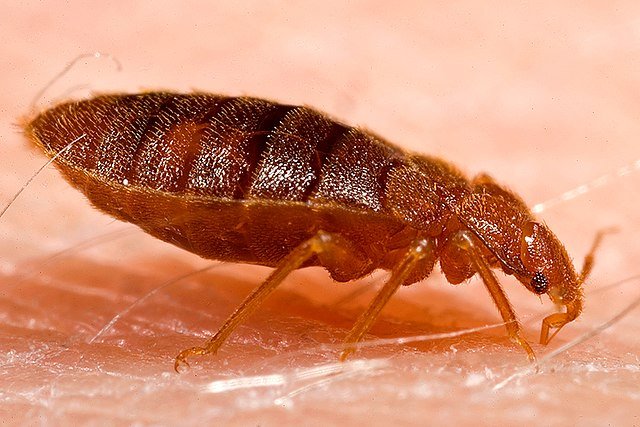Carpenter Bees: Identification, Biology, Risks, and Control
 The carpenter bee (Xylocopa spp.) is one of the most misunderstood insects found around homes and gardens. These large bees resemble bumble bees (Bombus spp.) but differ significantly in their nesting habits. Instead of building colonies underground or in hives, carpenter bees excavate tunnels in wood to lay their eggs.
The carpenter bee (Xylocopa spp.) is one of the most misunderstood insects found around homes and gardens. These large bees resemble bumble bees (Bombus spp.) but differ significantly in their nesting habits. Instead of building colonies underground or in hives, carpenter bees excavate tunnels in wood to lay their eggs.
While they are valuable pollinators and rarely aggressive toward humans, their tunneling activity can damage untreated wood on houses, fences, decks, and barns. Over time, this damage may weaken structures or create entry points for moisture and pests.
This dual role—beneficial pollinator and potential nuisance—makes carpenter bees a fascinating yet sometimes problematic insect. Understanding their biology, distribution, and control is essential for homeowners and pest management professionals.
Identification
Physical features
Size: Adults are 12–25 mm long, making them among the largest bees in North America.
Color: Black, often with a metallic blue or green sheen. Some species have yellow or white hairs on the thorax.
Abdomen: Shiny and hairless, unlike the fuzzy abdomen of bumble bees.
Males vs. females: Males often have a white or yellow patch on the face. Females lack this marking and are capable of stinging.
Behavior
Solitary nesters: Each female constructs her own tunnel, though multiple tunnels may appear in the same wooden structure.
Buzzing flight: Loud, hovering flight patterns near eaves or fences often signal carpenter bee activity.
Territorial males: Males hover aggressively near people but cannot sting.
Distinction from other bees
Carpenter bees (Xylocopa spp.): Shiny abdomen, wood-boring behavior.
Bumble bees (Bombus spp.): Hairy abdomen, nest in soil or cavities, form colonies.
Honey bees (Apis mellifera): Golden-brown, smaller, social, live in large hives.
Biology and Ecology
Nesting behavior
Carpenter bees bore round entry holes, usually 10–12 mm in diameter, into softwoods such as pine, cedar, or redwood. Behind the entry, they excavate tunnels 15–30 cm long, where they deposit pollen balls and eggs.
Each cell is sealed with a plug of chewed wood. Larvae develop inside, pupate, and emerge as adults in late summer. These new adults overwinter in the tunnels and emerge again in spring to repeat the cycle.
Diet
Adults feed on nectar and pollen.
They visit many flowering plants, including fruit trees, clover, and garden vegetables.
While they do not produce honey, they are effective pollinators.
Reproduction
One generation per year in temperate regions.
In warmer climates, multiple generations may occur.
Females reuse old tunnels or expand them, leading to cumulative damage.
Ecological role
Important pollinators of open-faced flowers.
Can perform “nectar robbing” by cutting holes in flowers, bypassing pollination.
Provide food for predators such as woodpeckers, which often damage wood further while seeking larvae.
Global Distribution
Carpenter bees belong to the genus Xylocopa, with over 500 species worldwide.
North America: Xylocopa virginica is widespread in the eastern U.S. and southern Canada.
Europe: Xylocopa violacea (violet carpenter bee) is common across Mediterranean regions and spreading north due to climate change.
Asia: Multiple species inhabit tropical and subtropical regions.
Africa & South America: Rich diversity in warm, forested habitats.
Their preference for untreated or weathered wood means they thrive in both natural forests and human structures.
Risks and Damage
Structural damage
Tunnels weaken beams, decks, and siding when infestations persist over years.
Entry holes allow moisture, fungi, and secondary pests to invade wood.
Repeated use of old tunnels expands damage significantly.
Human concerns
Females can sting if handled, but generally avoid confrontation.
Males are aggressive in flight but harmless.
Buzzing flight around homes often causes unnecessary alarm.
Agricultural impact
Generally beneficial as pollinators.
In rare cases, excessive nectar robbing reduces crop pollination efficiency.
Signs of Infestation
Perfectly round holes in wooden surfaces, about 10–12 mm wide.
Sawdust piles beneath entry points from tunneling activity.
Yellow-brown staining on wood from fecal matter near entrances.
Buzzing bees hovering around eaves, fences, and decks.
Woodpecker damage caused by birds seeking larvae inside tunnels.
Control Methods
Prevention
Paint or varnish exposed wood, since carpenter bees prefer untreated surfaces.
Use hardwoods for construction, which are less attractive than softwoods.
Seal cracks and old tunnels to prevent reuse.
Physical control
Plug holes with wooden dowels and seal with caulk or paint after bees have emerged.
Apply screens or mesh to protect vulnerable structures.
Remove heavily damaged wood sections and replace them.
Chemical control
Insecticidal dust applied directly into tunnels kills larvae and adults.
Residual sprays on wood surfaces deter new tunneling.
Professional treatments are recommended for heavy infestations.
Advanced Approaches
Biological controls: Research explores natural predators and fungal pathogens to manage populations.
Decoy wood blocks: Placing untreated wood away from structures can lure bees to nest elsewhere.
Non-toxic repellents: Citrus oil, almond oil, and peppermint oil sprays deter nesting.
Integrated pest management (IPM): Combines prevention, monitoring, and selective treatments.
Climate considerations: Warming climates expand carpenter bee ranges, requiring adaptive strategies.
Cultural and Historical Context
Carpenter bees have fascinated humans for centuries.
In Mediterranean folklore, the violet carpenter bee (Xylocopa violacea) was seen as a symbol of good fortune.
In some Native American traditions, carpenter bees were noted as diligent woodworkers, respected for their persistence.
In modern culture, their loud buzzing often associates them with fear, though they are far less dangerous than yellowjackets or hornets.
Their reputation continues to oscillate between nuisance and beneficial insect, depending on whether one values wood preservation or pollination.
FAQ Section
Q1: Do carpenter bees eat wood?
No. They excavate wood to create nests but do not consume it.
Q2: Can carpenter bees sting?
Females can sting but rarely do. Males cannot sting.
Q3: Do carpenter bees damage houses?
Yes. Over time, repeated tunneling weakens wooden structures.
Q4: Are carpenter bees good pollinators?
Yes. They pollinate many plants, though they sometimes rob nectar without pollinating.
Q5: How do you stop carpenter bees naturally?
Painting wood, sealing tunnels, and using citrus or peppermint oils help deter them.
Q6: What attracts carpenter bees to wood?
They prefer untreated, weathered softwood for tunneling.
Q7: Can old carpenter bee holes be reused?
Yes. Females often expand existing tunnels year after year.
Q8: Do carpenter bees make honey?
No. They do not live in hives or produce honey like Apis mellifera.
Final Thoughts
The carpenter bee (Xylocopa spp.) is both a valuable pollinator and a structural nuisance. While their tunneling habits can damage untreated wood over time, they also contribute significantly to pollination, especially for open-faced flowers and crops. Their behavior highlights the delicate balance between human needs and ecological roles.
For property owners, the best strategy is prevention: sealing or painting wood, monitoring early activity in spring, and addressing tunnels before they multiply. In cases of severe infestation, licensed pest control professionals should be contacted to ensure safe and effective management. Looking ahead, eco-friendly repellents, biological controls, and integrated pest management (IPM) approaches will likely play a larger role in balancing pollinator conservation with property protection.
Disclaimer
This article is for informational purposes only. Pest control laws and approved chemicals vary by country. For best results and legal safety, we strongly recommend contacting a licensed pest control professional in your local area. Always make sure that the pest control technician is properly certified or licensed, depending on your country’s regulations. It’s important to confirm that they only use approved products and apply them exactly as instructed on the product label. In most places in Europe, UK, or USA, following label directions is not just best practice—it’s the law.
Author Bio
Nasos Iliopoulos
BSc Agronomist & Certified Pest Control Expert
Scientific Director – Advance Services (Athens, Greece)
Licensed Pest Control Business – Ministry of Rural Development & Food (GR)
References
Wikipedia - Carpenter Bee
Penn University - The Eastern Carpenter Bee

